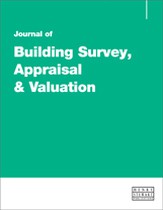Can positive input ventilation tackle surface condensation and mould growth? Literature review and case study of a UK dwelling
Abstract
Insufficient ventilation is one of the main factors leading to damp and mould in residential buildings. One low-cost method to improve these moisture-related issues is positive input ventilation (PIV) but research data on performance is scarce in the literature. This paper presents a bibliographical review together with a case study based on monitoring a residential building by means of environmental sensors. The review reveals the importance of correct location, installation, operation and continued maintenance of mechanical ventilation systems. Specifically, PIV and exhaust ventilation units in existing buildings require routine checking to ensure these systems are working correctly and efficiently. The results of monitoring ambient and surface temperature and relative humidity show that the PIV and enhancement extract fan set-up can reduce atmospheric moisture levels and avoid surface condensation. Mould growth is no longer active, but it is always essential to perform thoughtful building inspections checking the right conditions for installation and maintenance to ensure the proper functioning of the units. It is critical to study the size of the building and structural characteristics of the roof and ceilings. Also to verify that the doors are well undercut to allow air flow and that the occupancy levels and regional climate are adequate for selecting the appropriate type of mechanical ventilation units and corresponding operational modes (flow rates, operational settings, etc.). More research, measurements and monitoring studies pre- and post-installation of PIV and other whole house mechanical ventilation systems are recommended to assess optimal performances. This could also help to ensure the success of retrofitting projects in residential buildings which aim to improve energy efficiency but also make buildings relatively airtight and prone to condensation damp. An effective, sufficient and appropriate ventilation system as well as a good installation practice and adequate maintenance is key to avoid surface condensation and mould growth and to improve the indoor air quality of both new and existing buildings.
The full article is available to subscribers to the journal.
Author's Biography
Paula Lopez-Arce PhD currently works as Head of Research at The Property Care Association (PCA), co-director and Head of Research and Development (R&D) and Innovation at Maple Research and Development Ltd. She also holds an Honorary Research Fellow position at the Institute for Environmental Design and Engineering (IEDE) of University College London (UCL) and serves as external adviser researcher to co-supervise PhD students at Leeds Becket University, Leeds Sustainability Institute (LSI), School of Built Environment, Engineering and Computing. She holds a PhD on earth science and geological processes obtained in 2004 at Complutense University of Madrid (Spain). During the last 22 years she has been working as a research scientist and project manager on knowledge transfer research projects between industry and academia, ie trade associations, universities, museums and other institutions in Europe, UK, Australia and America, gaining a strong expertise in conservation science, architectural and archaeological heritage. Her research lines and numerous publications include scientific articles, book chapters and conference proceedings in the following topics: I) characterisation of building materials and products (stone, bricks, mortars, cements, ceramics, nanoparticles, etc.); 2) identification of causes of decay (rising damp, atmospheric moisture, mould growth, salt crystallisation, environmental pollution); 3) diagnostic methods based on analysis, testing, measuring and monitoring the built environment (use of data loggers and non-destructive techniques, physico-chemical analyses and standard tests) to assess the effect of moisture, conservation products and rectification treatments, and the compatibility and durability of materials and structures for the preservation of both residential and historic buildings. At Maple R&D she works on research and development of innovate diagnostic systems applied to measure and monitor the environmental conditions. One main goal is to quantify moisture levels and to assess the root cause and severity of related problems such as condensation damp and mould growth for gaining more resilient properties and getting better indoor air quality living environments.
Citation
Lopez-Arce, Paula (2023, March 1). Can positive input ventilation tackle surface condensation and mould growth? Literature review and case study of a UK dwelling. In the Journal of Building Survey, Appraisal & Valuation, Volume 11, Issue 4. https://doi.org/10.69554/GLGN3907.Publications LLP
